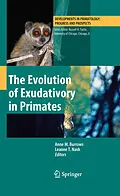The Evolution of Exudativory in Primates is the first edited volume to offer a comprehensive overview of this rare dietary niche in the primate order. Leading researchers in the field of primatology synthesize our current knowledge of the behavioral, socioecological, nutritional, morphological, and evolutionary aspects of exudate-feeding in primates. The Evolution of Exudativory in Primates covers exudate-feeding in callitrichines, callimicos, mouse lemurs, lorises, and galagos. Advances in our understanding of how these animals obtain their food and digest it, how this food resource affects social relationships, and how morphology is related to exudate-feeding are presented in subsequent essays. The final chapter synthesizes current data on what role exudate-feeding may have played in the earliest primates, the plesiadapiforms, and what exudate-feeding signals may be present in the fossil record. Ideal for upper-level undergraduate and graduate primatology courses, The Evolution of Exudativory in Primates can also be used for courses in biology, comparative mammalogy, and conservation. About the Editors: ANNE M. BURROWS is an Associate Professor in the Department of Physical Therapy at Duquesne University and a Research Associate Professor in the Department of Anthropology at the University of Pittsburgh. She has worked on the functional and evolutionary morphology of the primate craniofacial complex with a focus on strepsirrhines. LEANNE T. NASH is a Professor of Anthropology in the School of Human Evolution and Social Change at Arizona State University. She has worked extensively with a captive colony of Galago senegalensis held previously at ASU for 20 years. She has also done fieldwork in Africa and Madagascar on baboons, galagos, and sportive lemurs. Other collaborations have been on captive chimpanzee behavior with the Primate Foundation of Arizona.
Zusammenfassung
I first became involved in research into primate behavior and ecology in 1968, over 40 years ago, driven by a quest for a better understanding of the natural context of primate evolution. At that time, it was virtually unknown that primates can exploit exudates as a major food source. I was certainly unaware of this myself. By good fortune, I was awarded a postdoctoral grant to work on lemurs with Jean-Jacques Petter in the general ecology division of the Muséum National d'Histoire Naturelle in Brunoy, France. This provided the launching-pad for my first field study of lesser mouse lemurs in Madagascar, during which I gained my initial inklings of exudate feeding. It was also in Brunoy that I met up with Pierre Charles- Dominique, who introduced me to pioneering observations of exudate feeding he had made during his field study of five lorisiform species in Gabon. This opened my eyes to a key feeding adaptation that has now been reported for at least 69 primate species in 12 families (Smith, Chap. 3) almost 20% of extant primate species. So exudativory is now firmly established as a dietary category for p- mates, alongside the long-recognized classes of faunivory (including insectivory), frugivory, and folivory. Soon after I encountered Charles-Dominique, he published the first synthetic account of his Gabon field study in a French language journal (Charles-Dominique 1971).
Inhalt
Introduction: Advances and Remaining Sticky Issues in the Understanding of Exudativory in Primates.- Nutritional and Digestive Challenges to Being a Gum-Feeding Primate.- Exudativory in Primates: Interspecific Patterns.- The Ecology of Exudate Production and Exudate Feeding in Saguinus and Callimico.- Influences on Gum Feeding in Primates.- Gummivory in Cheirogaleids: Primitive Retention or Adaptation to Hypervariable Environments?.- Seasonality in Gum and Honeydew Feeding in Gray Mouse Lemurs.- Comparative Ecology of Exudate Feeding by Lorises (Nycticebus, Loris) and Pottos (Perodicticus, Arctocebus).- Exudativory and Primate Skull Form.- A Comparative Analysis of the Articular Cartilage in the Temporomandibular Joint of Gouging and Nongouging New World Monkeys.- Searching for Dental Signals of Exudativory in Galagos.- A Guide to Galago Diversity: Getting a Grip on How Best to Chew Gum.- Tongue Morphology in Infant and Adult Bushbabies (Otolemur spp.).- Adaptive Profile Versus Adaptive Specialization: Fossils and Gummivory in Early Primate Evolution.
